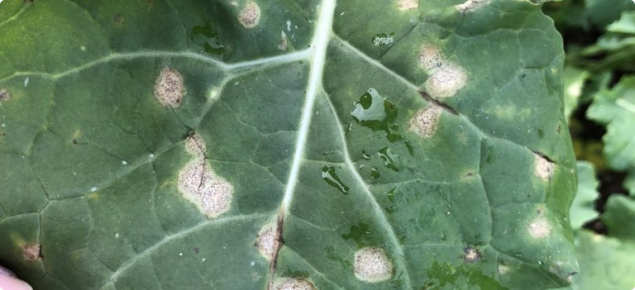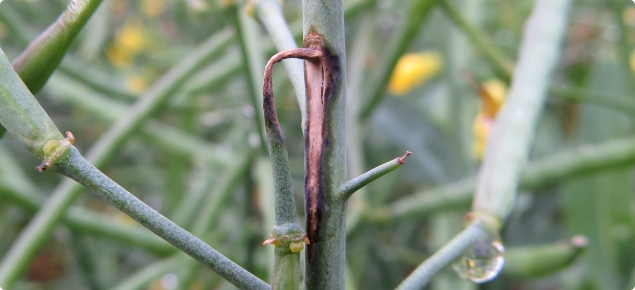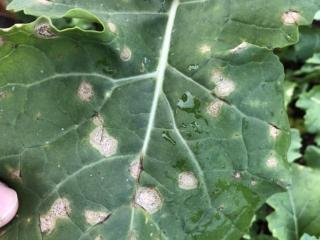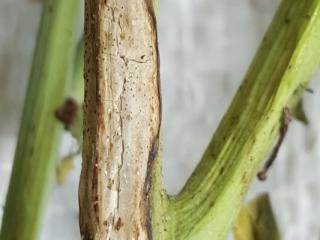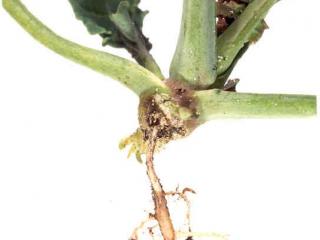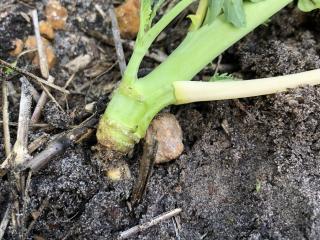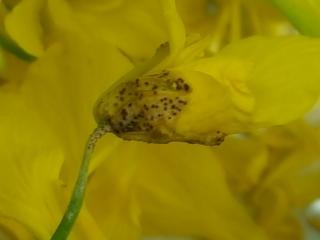Blackleg, caused by the fungus Leptosphaeria maculans, is one of the most serious diseases of canola in Western Australia. Blackleg can cause significant damage by infecting the cotyledons or first leaves early in the season, leading ultimately to crown lesions or cankers later in the season. Changes in variety choice, earlier sowing times and stubble retention have extended the risk of blackleg disease. Now, because of early emergence, later stages of crop growth are more likely to be exposed and infection can occur on all parts of the plant above ground, including canola flowers, stems and branches. To assist with diagnosis, symptoms of the disease are described in detail on the Diagnosing blackleg in canola page. A diagnosis service is also available through the department's DDLS - Plant pathology services (this is a chargeable service).
Disease development and spread
Several factors contribute to development of the disease. While the major source of primary inoculum is canola residue, the inoculum is also carried over by infected seed (Diagram 1). However, the impact of carry-over of inoculum on seed is very low when compared with the inoculum carry-over on residues.
Seasonal conditions have a major influence on the level of disease. Rains in late autumn and throughout winter stimulate the release of blackleg spores from canola residue present on the surface of paddocks.
Blackleg is spread primarily by wind, with the heaviest spore fall out normally occurring within 500 metres of any canola residue. Each year canola residue continues to produce blackleg spores at a diminishing rate until the stubble has completely broken down (see Diagram 2).
In WA, this breakdown could take up to four years, and so the recommendation is for long rotations.
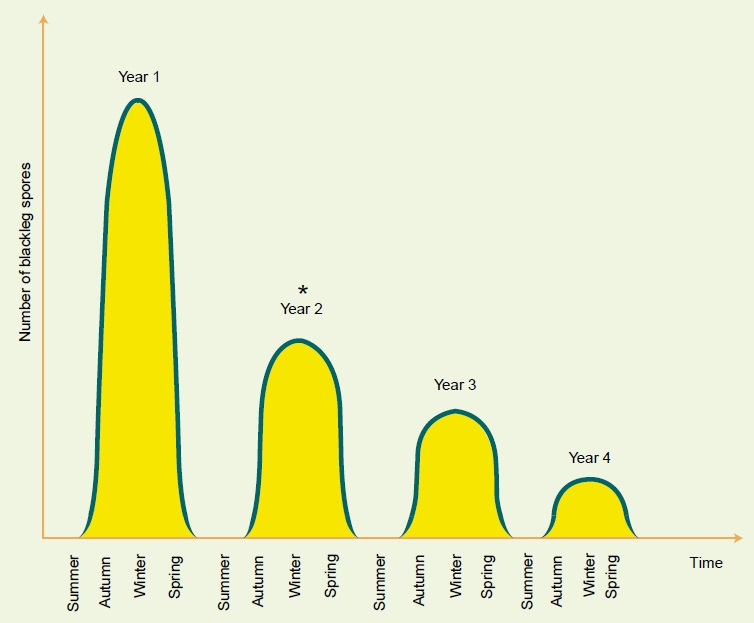
Intensity of spore release from ageing canola stubble over a four year period in Western Australia (spore release in the first and the second year based upon the field trials).
* Spore release from residues in year 2 are similar to release from residues that were raked and burnt in the first year.
Please report disease finds to PestFax for the benefit of all industry to be aware of disease occurrences and spread.
Seedling infection from blackleg
Blackleg can attack the crop at any stage, but early seedling infections are most critical in terms of the development of severe stem cankers (Diagram 1). Stem cankers from blackleg infection on canola seedlings cause a constriction in the stem just below the first leaves but above the ground leading to yield loss.
Heavy seedling losses can occur under very high disease pressure and in environments favourable to blackleg development, for example, where canola is planted on top of, or immediately downwind of last year’s or the previous season’s canola crop.
The blackleg fungus can attack all aerial parts of the plant. However, it is the less obvious infection of the crown region (junction of root base and stem) that causes the largest grain yield loss from blackleg. Canola seedlings of many varieties are susceptible to blackleg until they achieve a degree of adult plant resistance, usually at about the six leaf stage. While leaf infection is the most obvious symptom, high levels of leaf infections after six leaf stage do not necessarily indicate that major losses will occur from blackleg.
Fungicide strategies to minimise canker infections include fungicide seed dressings and/or fungicide in-furrow treatments. Foliar fungicide applications at the 4-6 leaf stages should not be necessary if other management guidelines are followed.
Upper canopy infection
The blackleg fungus is capable of attacking all aerial parts of the plant throughout the growing season.Wet spring conditions can be conducive to aerial blackleg, which impacts flowers, stems, branches and pods. Upper canopy infection (UCI) is the collective term for blackleg flower, petiole, pod, main stem and branch infection but does not include leaf lesions or crown canker.
Important factors in the development of UCI are: flowering time, seasonal conditions relating to spore development and release, infection events, variety resistance and the interactions of these factors.
Although infection of the crown is the most damaging phase of the disease, infection of the upper canopy (UCI) can sometimes lead to severe yield losses. Pod lesions can impact yield but stem and branch lesions are the most damaging. The extent of yield loss will vary by season and is still being studied as aspects such as variety resistance is under complex genetic control.
Symptoms of UCI include the presence of abundant pycnidia (black specks) in affected plant parts. Lesions on the stems and branches are usually elongated with a dark margin and white centre with pycnidia. Occasionally the entire flowering head is colonised by the fungus causing it to droop and shrivel.
Effective major gene resistance provides control of UCI; if you see no blackleg lesions on leaves throughout the season then major gene resistance is likely to be active. Upper canopy infection is more frequently observed in canola varieties that have low to moderate resistance to blackleg and particularly in varieties with group C resistance and/or varieties that have recently been downgraded for resistance to blackleg. It has been found to be more severe in crops that are sown in short canola rotations.
Foliar fungicide application for managing UCI has highly variable responses. Research is in progress in WA and eastern Australia under the GRDC funded National Canola Pathology project to investigate various strategies for controlling the upper canopy blackleg infection. Research is being conducted by DPIRD on foliar fungicide application timing and determination of economic returns.
Adopt a proactive and integrated way of managing blackleg
Managing blackleg has the same underlying principles no matter what the level of disease intensity is likely to be. It is very important that you take an integrated approach and do not rely on the use of fungicides only. Canola stubbles of any age are a source of inoculum. There are five main ways of minimising the risk of blackleg becoming a threat to your canola this season:
- Choose the best adapted variety for your area with the highest level of blackleg/crown canker resistance. See WA blackleg resistance ratings on canola varieties in the latest canola variety guide. If you have grown the same cultivar for three years or more and have suffered yield loss due to blackleg, choose to grow a cultivar from a different resistance group.
- Choose the right paddock and minimise high disease risk situations. Avoid paddocks with recent canola residues (1-2 years). Maximise the distance between last year’s infected residue and this year’s crop; upwind is better.
- Minimise the risk of seedling emergence and early seedling development coinciding with spore showers if you can. Before seeding, check the department’s latest canola blackleg risk forecast for your area.
- Reduce existing canola residue by raking, burning and/or burying (grazing can also be considered, but it is of limited value as the woody infected crowns are not eaten by stock).
- Crop protection fungicides are important tools for managing blackleg. Fungicides should be used wisely and where appropriate, as these are only a part of the overall risk management strategy against this disease. Relying only on fungicides to control blackleg creates a high risk of fungicide resistance developing. Refer to Blackleg CM a decision support tool to assist with determining the likely value of fungicide application.
For further details on blackleg management and current blackleg ratings refer to GRDC’s latest Blackleg Management Guide.
Varietal response to different disease pressures
Four main categories of blackleg disease pressures have been described based upon the age of the residues in the current paddock and adjoining paddocks, especially if the new canola crop is planned for sowing downwind of the residues (Table 1). These disease pressure categories apply to all rainfall zones, although the final disease severity can be influenced by the amount and frequency of rainfall. For example, in high rainfall areas, disease severity is likely to be higher than medium and low rainfall areas under the same residue exposure situations.
| Age of residues* within 500m | Age of residues directly sown into: previous season | Age of residues directly sown into: two season | Age of residues directly sown into: three season | Age of residues directly sown into: four season | No residues |
|---|---|---|---|---|---|
| One season | Very high | Very high | High | Moderate | Moderate |
| Two season | Very high | Very high | Moderate | Moderate | Moderate |
| Three season | Very high | High | Moderate | Low | Low |
| Four season | Very high | High | Moderate | Low | Low |
| No residues | Very high | High | Low | Low | Low |
* the term residues here indicates unraked, unburnt or ungrazed
However, to assist growers in assessing the potential yield loss if no fungicide is used, Table 2 has been developed using four very common disease categories based on WA trial data. Please refer to current Blackleg resistance ratings in the latest canola variety guide for further information. When growing highly resistant varieties no fungicide protection against blackleg is needed.
| Varieties with WA blackleg resistance rating | Low pressure | Moderate pressure | High pressure | Very high pressure |
|---|---|---|---|---|
| MS-S | 15% | 40% | 70% | 100% |
| MS | 15% | 35% | 65% | 100% |
| MR-MS | 10% | 30% | 60% | 90% |
| MR | 5% | 15% | 40% | 85% |
| R-MR | low | 10% | 40% | 80% |
| R | low | low | low | unknown |
* The yield losses from blackleg in varieties with different blackleg resistance ratings are calculated from actual yields obtained from WA trials conducted under different disease pressures
Genetic blackleg resistance being threatened
Varieties with very high resistance to blackleg (blackleg rating R) are available but the very high level of host resistance in these varieties are probably controlled by one or more major gene(s). These highly resistant varieties exert selection pressure on the blackleg fungus to overcome the major resistance gene(s). As area sown to these highly resistant varieties increases, the selection pressure on the pathogen to overcome resistance increases. Even where integrated management practices are being employed, intensive canola cropping cycles are eroding genetic blackleg resistance at a very fast rate. It should be noted that the virulence of local blackleg pathogen populations and cultivar resistance ratings may vary between regions and through cropping cycles so it's important to assess your risk paddock by paddock.
Minimising the risk of blackleg spore showers
Blackleg spores are released from infected canola residues throughout the season, however, their commencement and intensity varies from season to season and region to region depending upon the weather conditions (Diagram 3).
In high rainfall southern regions the release of spores generally starts earlier compared with the low rainfall northern regions. In the northern region, if canola crops are sown prior to May, blackleg risk is low because the early seedling growth phase has usually been completed before the onset of heavy ascospore showers.
Most canola varieties are susceptible as seedlings to blackleg up to eight weeks from emergence. This gives an opportunity to assess the risk associated with the major ascospore showers coinciding with the most susceptible stage of the crop and, in some areas and seasons, to adopt a management strategy to minimise blackleg infection. Extensive research has been conducted on the timing of spore release in different regions and a model (Blackleg Sporacle) has been developed by DPIRD to predict the timing of spore release in different regions. Using daily temperature and rainfall inputs over summer and autumn, the model can provide a seasonal estimate on the arrival of the first ascospore showers.
The Blackleg Sporacle Model and the Blackleg CM decision support tool
DPIRD's Blackleg Sporacle model can provide growers with an early warning to avoid the ascospore showers at the critical stage of susceptibility by manipulating the time of sowing the crops if possible. A forecast on the likelihood of first spore showers is available to growers via the Crop diseases: forecasts and management page which is updated regularly at fortnightly intervals from the commencement of every season. The blackleg sporacle model predicts the onset of blackleg ascospore release from canola stubble for 26 canola growing districts of WA using the latest weather data from the nearest weather stations to these locations. Growers are recommended to check the forecasts prior to sowing.
BlacklegCM is a decision support tool developed by DPIRD and available for use on ipad and android tablets that assists with managing blackleg disease in canola crops in Australia. The app has been developed to provide growers and advisers with an interactive interface to explore the economic outcomes of different blackleg management strategies and their relative importance. Blackleg CM allows you to compare the likely profitability of different disease management strategies including paddock selection, variety choice, seed dressing, banded fungicide and foliar fungicide. BlacklegCM takes account of costs, yield benefits, grain price and seasonal conditions to give you best case, worst case and most likely estimates of financial return. The app harnesses 30 years worth of data and information compiled in the Blackleg Management Guide to help identify the most profitable management strategy for individual scenarios. The University of Melbourne, NSW Department of Primary Industries, CSIRO, the South Australian Research and Development Institute, and Victorian consultants Marcroft Grains Pathology also contributed to the development of the app. BlacklegCM does not account for all factors that can affect blackleg disease, so information provided by this tool should not be considered to be tailored to the circumstances of any individual farm. You can download the BlacklegCM App from the BlacklegCM page. For more information on Blackleg cankar and how to use the BlacklegCM tool refer to BlacklegCM webinar.
Fungicide application
Fungicides at seeding
A range of fungicides are registered as in-furrow treatments or seed dressings to suppress blackleg. These can give useful protection, especially during crop establishment. A variety with moderate canker resistance or lower that is exposed to moderate to high disease pressure is likely to achieve an economic return from fungicides applied in-furrow or on seed.
Apply products according to label recommendations and for in-furrow treatment apply them as close as possible to the seed for maximum effectiveness. Canola roots must grow through the fungicide treated fertiliser to achieve an effective uptake of the fungicide. Uneven application and poor placement of the fertiliser could seriously reduce the fungicide effectiveness. However, in-furrow treatments should not be applied directly to the seed as it is toxic.
You need to assess your own situation with your adviser to decide whether you should consider the use of fungicides at seeding or not. The point at which it becomes economic to apply them depends on the cost of application and potential yield loss prevented by its application. Their effectiveness is largely dependent on the amount of disease pressure and the level of varietal resistance.
To look at the gross margins with or without using flutriafol or a seed dressing under various disease pressures in your region with your varieties please use the BlacklegCM decision support tool which is available for free download on the app and google play stores.
Foliar fungicides
There are several foliar fungicides registered to manage blackleg in canola. These are listed on the page Registered foliar fungicides for canola in Western Australia.
Seedling infection
Foliar fungicide can be applied at the 4-6 leaf stage where crops are in high disease pressure situations. These applications should not be necessary if management guidelines are followed but may be considered if disease severity is very high in a variety with a low level of blackleg resistance or if its resistance has been overcome by the pathogen. Follow product labels carefully.
Fungicide resistance
Resistance to the fungicides flutriafol and fluquinconazole (seed dressing Jockey®) has been found in several locations across WA. If you suspect a fungicide failure, stubble samples can be submitted for testing. Please contact Andrea Hills for submission instructions.
Upper canopy infection (UCI)
Currently, no control measures are recommended for managing UCI but research is in progress in WA and eastern Australia under the GRDC funded National Canola Pathology project to investigate various strategies for controlling the upper canopy blackleg infection. Research indicates that spraying at 30% bloom for sclerotinia control may reduce UCI symptoms if the season is conducive to disease development but there is insufficient knowledge or economic analysis to recommend spraying solely for UCI control.
For further details on blackleg management and current blackleg ratings refer to GRDC’s latest Blackleg Management Guide.
Acknowledgement
These recommendations for the management of blackleg disease are based on research carried out at DPIRD. Acknowledgement to GRDC for co-funding the research through two projects, the National Canola Pathology Project, and National Pathogen Management Modelling and Delivery of Decision Support.



